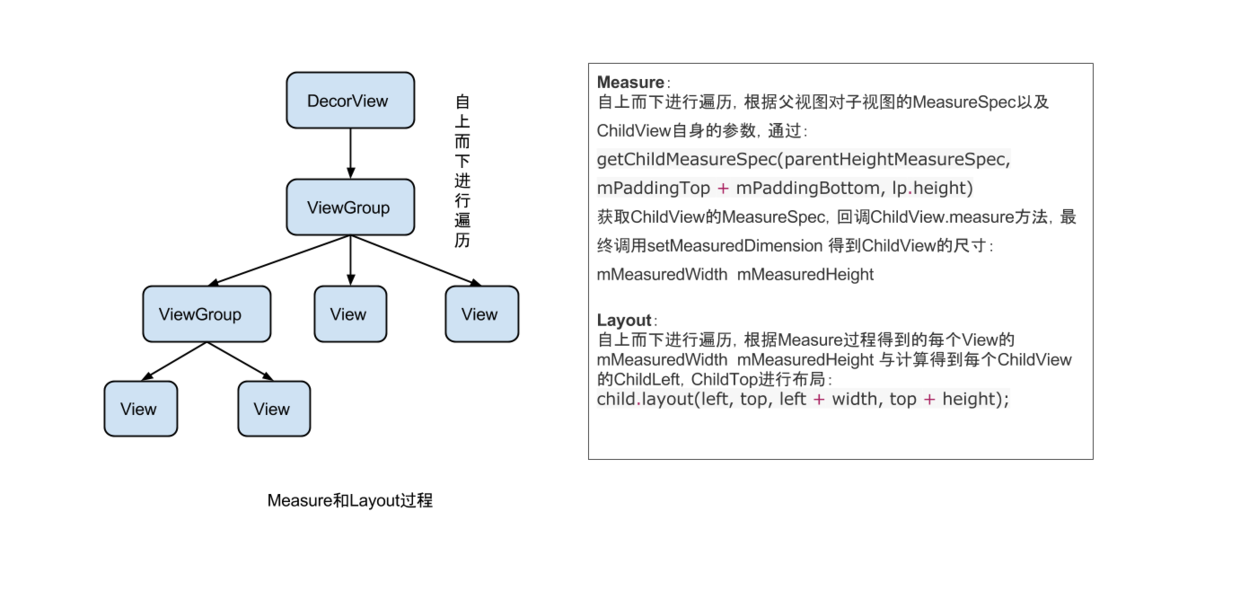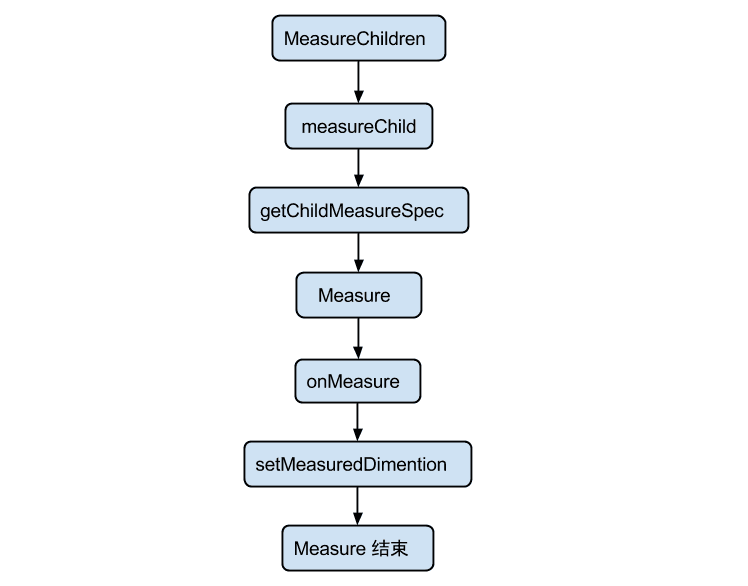2019 年百度 Android 面试题 - 公共技术点之 -View- 绘制流程
当 Activity 接收到焦点的时候,它会被请求绘制布局,该请求由 Android framework 处理.绘制是从根节点开始,对布局树进行 measure 和 draw。整个 View 树的绘图流程在 ViewRoot.java 类的 performTraversals()函数展开,该函数所做 的工作可简单概况为是否需要重新计算视图大小(measure)、是否需要重新安置视图的位置(layout)、以及是否需要重绘(draw),流程图如下:

View 绘制流程函数调用链

需要说明的是,用户主动调用 request,只会出发 measure 和 layout 过程,而不会执行 draw 过程 2. 概念 measure 和 layout 从整体上来看 Measure 和 Layout 两个步骤的执行:

树的遍历是有序的,由父视图到子视图,每一个 ViewGroup 负责测绘它所有的子视图,而最底层的 View 会负责测绘自身。
具体分析 measure 过程由 measure(int, int)方法发起,从上到下有序的测量 View,在 measure 过程的最后,每个视图存储了自己的尺寸大小和测量规格。 layout 过程由 layout(int, int, int, int)方法发起,也是自上而下进行遍历。在该过程中,每个父视图会根据 measure 过程得到的尺寸来摆放自己的子视图。
measure 过程会为一个 View 及所有子节点的 mMeasuredWidth 和 mMeasuredHeight 变量赋值,该值可以通过 getMeasuredWidth()和 getMeasuredHeight()方法获得。而且这两个值必须在父视图约束范围之内,这样才可以保证所有的父视图都接收所有子视图的测量。如果子视图对于 Measure 得到的大小不满意的时候,父视图会介入并设置测量规则进行第二次 measure。比如,父视图可以先根据未给定的 dimension 去测量每一个子视图,如果最终子视图的未约束尺寸太大或者太小的时候,父视图就会使用一个确切的大小再次对子视图进行 measure。
measure 过程传递尺寸的两个类
1.ViewGroup.LayoutParams (View 自身的布局参数)2.MeasureSpecs 类(父视图对子视图的测量要求)ViewGroup.LayoutParams 这个类我们很常见,就是用来指定视图的高度和宽度等参数。对于每个视图的 height 和 width,你有以下选择:
1.具体值 2.MATCH_PARENT 表示子视图希望和父视图一样大(不包含 padding 值)3.WRAP_CONTENT 表示视图为正好能包裹其内容大小(包含 padding 值)
ViewGroup 的子类有其对应的 ViewGroup.LayoutParams 的子类。比如 RelativeLayout 拥有的 ViewGroup.LayoutParams 的子类 RelativeLayoutParams。有时我们需要使用 view.getLayoutParams() 方法获取一个视图 LayoutParams,然后进行强转,但由于不知道其具体类型,可能会导致强转错误。其实该方法得到的就是其所在父视图类型的 LayoutParams,比如 View 的父控件为 RelativeLayout,那么得到的 LayoutParams 类型就为 RelativeLayoutParams。
MeasureSpecs 测量规格,包含测量要求和尺寸的信息,有三种模式:
1.UNSPECIFIED 父视图不对子视图有任何约束,它可以达到所期望的任意尺寸。比如 ListView、ScrollView,一般自定义 View 中用不到,
2.EXACTLY 父视图为子视图指定一个确切的尺寸,而且无论子视图期望多大,它都必须在该指定大小的边界内,对应的属性为 match_parent 或具体值,比如 100dp,父控件可以通过 MeasureSpec.getSize(measureSpec)直接得到子控件的尺寸。
3.AT_MOST 父视图为子视图指定一个最大尺寸。子视图必须确保它自己所有子视图可以适应在该尺寸范围内,对应的属性为 wrap_content,这种模式下,父控件无法确定子 View 的尺寸,只能由子控件自己根据需求去计算自己的尺寸,这种模式就是我们自定义视图需要实现测量逻辑的情况。
3. measure 核心方法
measure(int widthMeasureSpec, int heightMeasureSpec)该方法定义在 View.java 类中,为 final 类型,不可被复写,但 measure 调用链最终会回调 View/ViewGroup 对象的?onMeasure()方法,因此自定义视图时,只需要复写?onMeasure()?方法即可。
onMeasure(int widthMeasureSpec, int heightMeasureSpec)该方法就是我们自定义视图中实现测量逻辑的方法,该方法的参数是父视图对子视图的 width 和 height 的测量要求。在我们自身的自定义视图中,要做的就是根据该 widthMeasureSpec 和 heightMeasureSpec 计算视图的 width 和 height,不同的模式处理方式不同。
setMeasuredDimension()测量阶段终极方法,在?onMeasure(int widthMeasureSpec, int heightMeasureSpec)?方法中调用,将计算得到的尺寸,传递给该方法,测量阶段即结束。该方法也是必须要调用的方法,否则会报异常。在我们在自定义视图的时候,不需要关心系统复杂的 Measure 过程的,只需调用 setMeasuredDimension()设置根据 MeasureSpec 计算得到的尺寸即可,你可以参考?ViewPagerIndicator?的 onMeasure 方法。
下面我们取 ViewGroup 的?measureChildren(int widthMeasureSpec, int heightMeasureSpec)?方法对复合 View 的 Measure 流程做一个分析: MeasureChild 的方法调用流程图:

源码分析
/**
请求所有子 View 去 measure 自己,要考虑的部分有对子 View 的测绘要求 MeasureSpec 以及其自身的 padding
这里跳过所有为 GONE 状态的子 View,最繁重的工作是在 getChildMeasureSpec 方法中处理的
@param widthMeasureSpec 对该 View 的 width 测绘要求
@param heightMeasureSpec 对该 View 的 height 测绘要求*/protected void measureChildren(int widthMeasureSpec, int heightMeasureSpec) {final int size = mChildrenCount;final View[] children = mChildren;for (int i = 0; i < size; ++i) {final View child = children[i];if ((child.mViewFlags & VISIBILITY_MASK) != GONE) {measureChild(child, widthMeasureSpec, heightMeasureSpec);}}}
protected void measureChild(View child, int parentWidthMeasureSpec,int parentHeightMeasureSpec) {final LayoutParams lp = child.getLayoutParams();//获取 Child 的 LayoutParams
final int childWidthMeasureSpec = getChildMeasureSpec(parentWidthMeasureSpec,// 获取 ChildView 的 widthMeasureSpecmPaddingLeft + mPaddingRight, lp.width);final int childHeightMeasureSpec = getChildMeasureSpec(parentHeightMeasureSpec,// 获取 ChildView 的 heightMeasureSpecmPaddingTop + mPaddingBottom, lp.height);
child.measure(childWidthMeasureSpec, childHeightMeasureSpec);}
/**
该方法是 measureChildren 中最繁重的部分,为每一个 ChildView 计算出自己的 MeasureSpec。
目标是将 ChildView 的 MeasureSpec 和 LayoutParams 结合起来去得到一个最合适的结果。
@param spec 对该 View 的测绘要求
@param padding 当前 View 在当前唯独上的 paddingand,也有可能含有 margins
@param childDimension 在当前维度上(height 或 width)的具体指
@return 子视图的 MeasureSpec*/public static int getChildMeasureSpec(int spec, int padding, int childDimension) {
.........
// 根据获取到的子视图的测量要求和大小创建子视图的 MeasureSpecreturn MeasureSpec.makeMeasureSpec(resultSize, resultMode);
}
/***
用于获取 View 最终的大小,父视图提供了宽、高的约束信息
一个 View 的真正的测量工作是在 onMeasure(int, int) 中,由该方法调用。
因此,只有 onMeasure(int, int) 可以而且必须被子类复写
@param widthMeasureSpec 在水平方向上,父视图指定的的 Measure 要求
@param heightMeasureSpec 在竖直方向上,控件上父视图指定的 Measure 要求
*/public final void measure(int widthMeasureSpec, int heightMeasureSpec) {...
onMeasure(widthMeasureSpec, heightMeasureSpec);
...}
protected void onMeasure(int widthMeasureSpec, int heightMeasureSpec) {setMeasuredDimension(getDefaultSize(getSuggestedMinimumWidth(), widthMeasureSpec),getDefaultSize(getSuggestedMinimumHeight(), heightMeasureSpec));}
4. layout 相关概念及核心方法
首先要明确的是,子视图的具体位置都是相对于父视图而言的。View 的 onLayout 方法为空实现,而 ViewGroup 的 onLayout 为 abstract 的,因此,如果自定义的 View 要继承 ViewGroup 时,必须实现 onLayout 函数。
在 layout 过程中,子视图会调用 getMeasuredWidth()和 getMeasuredHeight()方法获取到 measure 过程得到的 mMeasuredWidth 和 mMeasuredHeight,作为自己的 width 和 height。然后调用每一个子视图的 layout(l, t, r, b)函数,来确定每个子视图在父视图中的位置。
LinearLayout 的 onLayout 源码分析
@Overrideprotected void onLayout(boolean changed, int l, int t, int r, int b) {if (mOrientation == VERTICAL) {layoutVertical(l, t, r, b);} else {layoutHorizontal(l, t, r, b);}}
/**
遍历所有的子 View,为其设置相对父视图的坐标*/void layoutVertical(int left, int top, int right, int bottom) {for (int i = 0; i < count; i++) {final View child = getVirtualChildAt(i);if (child == null) {childTop += measureNullChild(i);} else if (child.getVisibility() != GONE) {//不需要立即展示的 View 设置为 GONE 可加快绘制 final int childWidth = child.getMeasuredWidth();//measure 过程确定的 Widthfinal int childHeight = child.getMeasuredHeight();//measure 过程确定的 height
...确定 childLeft、childTop 的值
setChildFrame(child, childLeft, childTop + getLocationOffset(child),childWidth, childHeight);}}}
private void setChildFrame(View child, int left, int top, int width, int height) {
child.layout(left, top, left + width, top + height);}
View.javapublic void layout(int l, int t, int r, int b) {...setFrame(l, t, r, b)}
/**
为该子 View 设置相对其父视图上的坐标*/protected boolean setFrame(int left, int top, int right, int bottom) {...}
5. 绘制流程相关概念及核心方法
先来看下与 draw 过程相关的函数:
View.draw(Canvas canvas): 由于 ViewGroup 并没有复写此方法,因此,所有的视图最终都是调用 View 的 draw 方法进行绘制的。在自定义的视图中,也不应该复写该方法,而是复写?onDraw(Canvas)?方法进行绘制,如果自定义的视图确实要复写该方法,那么请先调用?super.draw(canvas)完成系统的绘制,然后再进行自定义的绘制。
View.onDraw():View 的 onDraw(Canvas)默认是空实现,自定义绘制过程需要复写的方法,绘制自身的内容。
dispatchDraw() 发起对子视图的绘制。View 中默认是空实现,ViewGroup 复写了 dispatchDraw()来对其子视图进行绘制。该方法我们不用去管,自定义的 ViewGroup 不应该对 dispatchDraw()进行复写。
绘制流程图

- View.draw(Canvas) 源码分析
/**
Manually render this view (and all of its children) to the given Canvas.
The view must have already done a full layout before this function is
called. When implementing a view, implement
{@link #onDraw(android.graphics.Canvas)} instead of overriding this method.
If you do need to override this method, call the superclass version.
@param canvas The Canvas to which the View is rendered.
根据给定的 Canvas 自动渲染 View(包括其所有子 View)。在调用该方法之前必须要完成 layout。当你自定义 view 的时候,
应该去是实现 onDraw(Canvas) 方法,而不是 draw(canvas) 方法。如果你确实需要复写该方法,请记得先调用父类的方法。*/public void draw(Canvas canvas) {
/ * Draw traversal performs several drawing steps which must be executed
in the appropriate order:
ore layers
*/
// Step 1, draw the background, if neededif (!dirtyOpaque) {drawBackground(canvas);}
// skip step 2 & 5 if possible (common case)final int viewFlags = mViewFlags;if (!verticalEdges && !horizontalEdges) {// Step 3, draw the contentif (!dirtyOpaque) onDraw(canvas);
// Step 4, draw the childrendispatchDraw(canvas);
// Step 6, draw decorations (scrollbars)onDrawScrollBars(canvas);
if (mOverlay != null && !mOverlay.isEmpty()) {mOverlay.getOverlayView().dispatchDraw(canvas);}
// we're done...return;}
// Step 2, save the canvas' layers...












评论